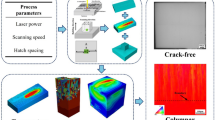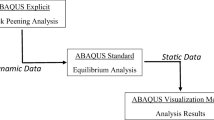Abstract
An integrated experimental and modeling/simulation approach was developed to investigate and secure a quantified knowledge of the impact of high temperature exposures on the stability of residual stresses in a laser shock peened (LSP) high temperature aero-engine alloy, IN718 SPF (super-plastically formed). Single dimple LSP and overlap LSP treatments were carried out utilizing a Nd:Glass laser (λ = 1.052 μm), and subsequent heat treatments on the LSP-treated coupons were conducted at different temperatures between 550 and 700 °C. A 3-D nonlinear finite element (FE) computational model and the rate-dependent Johnson-Cook material model were calibrated using the experimental results of residual stress from the single dimple LSP and thermal relaxation treatments, and were further extended to the overlap LSP treatment case. Both experimental and FE simulations show that: a) a high level of compressive residual stress (~700 MPa at surface) and residual stress depth (~0.4–0.6 mm) were achieved following LSP, and b) the overlap LSP treatment gave higher residual stress and greater depth. The magnitudes of the initial residual stress (and plastic strain), heating temperature and exposure time were identified as the key parameters controlling the thermal relaxation behavior. The stress relaxation mainly occurs initially before 20 min exposure and the extent of relaxation increases with an increase in temperature and a higher magnitude of the initial as-peened residual stress. In addition, in regions deeper than ~300 μm or after initial thermal exposure where the residual stress was lower than ~300 MPa, stress relaxation was found to be negligible. Kinetic analysis of the experimental thermal relaxation data based on Zener-Wert-Avrami model gave an activation enthalpy of 2.87 to 3.77 eV, which is near that reported in the literatures for volume and/or substitutional solute diffusion in Nickel. These results suggest that thermal relaxation of the LSP-induced residual stress occurs by a creep-like mechanism involving recovery, rearrangement and annihilation of dislocations by climb.













Similar content being viewed by others
References
Zhuang W, Wicks B (2003) Mechanical surface treatment technologies for gas turbine engine components. J Eng Gas Turbines Power-Trans ASME 125(4):1021–1025. doi:10.1115/1.1610011
Clauer AH, Lahrman DF (2001) Laser shock processing as a surface enhancement process. Key Eng Mater 197:121–144
Montross CS, Wei T, Ye L, Clark G, Mai YW (2002) Laser shock processing and its effects on microstructure and properties of metal alloys: a review. Int J Fatigue 24(10):1021–1036
Peyre P, Fabbro R (1995) Laser shock processing: a review of the physics and applications. Opt Quant Electron 27(12):1213–1229. doi:10.1007/bf00326477
Gill AS, Zhou Z, Lienert U, Almer J, Lahrman DF, Mannava SR, Qian D, Vasudevan VK (2012) High spatial resolution, high energy synchrotron x-ray diffraction characterization of residual strains and stresses in laser shock peened Inconel alloy 718SPF alloy. J Appl Phys 111(8):084904
Hornbach DJ, Prevey PS, Loftas EF (2007) Application of low plasticity burnishing (LPB) to improve the fatigue performance of Ti-6Al-4V femoral hip stems. In: Jerina KL (ed) Fatigue and Fracture of Medical Metallic Materials and Devices, vol 1481. American Society for Testing and Materials Special Technical Publication. 45–55
Rubio-Gonzalez C, Gomez-Rosas G, Ocana JL, Molpeceres C, Banderas A, Porro J, Morales A (2006) Effect of an absorbent overlay on the residual stress field induced by laser shock processing on aluminum samples. Appl Surf Sci 252(18):6201–6205. doi:10.1016/j.apsusc.2005.08.062
Nalla RK, Altenberger I, Noster U, Liu GY, Scholtes B, Ritchie RO (2003) On the influence of mechanical surface treatments-deep rolling and laser shock peening-on the fatigue behavior of Ti-6Al-4 V at ambient and elevated temperatures. Mater Sci Eng A 355:216–230
Zhou Z, Bhamare S, Ramakrishnan G, Mannava SR, Langer K, Wen Y, Qian D, Vasudevan VK (2012) Thermal relaxation of residual stress in laser shock peened Ti-6Al-4 V alloy. Surf Coat Technol 206(22):4619–4627. doi:10.1016/j.surfcoat.2012.05.022
Schafrik R, Sprague R (2008) Superalloy technology - a perspective on critical innovations for turbine engines. Key Eng Mater 380:113–134
McClung RC (2007) A literature survey on the stability and significance of residual stresses during fatigue. Fatigue Fract Eng Mater Struct 30(3):173–205
Holzapfel H, Schulze V, Vohringer O, Macherauch E (1998) Residual stress relaxation in an AISI 4140 steel due to quasistatic and cyclic loading at higher temperatures. Mater Sci Eng A 248:9–18
Lee H, Mall S (2004) Stress relaxation behavior of shot-peened Ti-6Al-4 V under fretting fatigue at elevated temperature. Mater Sci Eng A 366:412–420
Vohringer O, Hirsch T, Macherauch E (1984) Relaxation of shot peening induced residual stresses of Ti6Al4V by annealing or mechanical treatment. In: Proceedings of the 5th International Conference on Titanium, Munich, FRG. 2203–2210
Khadhraoui M, Cao W, Castex L, Guedou JY (1997) Experimental investigations and modelling of relaxation behaviour of shot peening residual stresses at high temperature for nickel base superalloys. Mater Sci Technol 13(4):360–367
Masmoudi N, Castex L, Bertoli A (1989) Influence of temperature and time on the stress relaxation process of shot peened IN100 superalloys. Mater Tech Paris 77(11–12):29–36
Cao W, Khadhraoui M, Brenier B, Guedou JY, Castex L (1994) Thermomechanical relaxation of residual-stress in shot peened nickel-base superalloy. Mater Sci Technol 10(11):947–954
Prevey P, Hornbach D, Mason P (1998) Thermal residual stress relaxation and distortion in surface enhanced gas turbine engine components. In: et.al. DLM (ed) Proceedings of the 17th Heat Treating Society Conference and Exposition and the 1st International Induction Heat Treating Symposium, ASM Materials Park, OH. 3–12
Buchanan DJ, John R, Brockman RA (2009) Relaxation of shot-peened residual stresses under creep loading. J Eng Mater Technol 131(3):031008
Braisted W, Brockman R (1999) Finite element simulation of laser shock peening. Int J Fatigue 21(7):719–724
Ding K, Ye L (2003) FEM simulation of two sided laser shock peening of thin sections of Ti-6Al-4 V alloy. Surf Eng 19(2):127–133
Ding K, Ye L (2003) Three-dimensional dynamic finite element analysis of multiple laser shock peening processes. Surf Eng 19(5):351–358
Hu Y, Yao Z, Hu J (2006) 3-D FEM simulation of laser shock processing. Surf Coat Technol 201:1426–1435
Peyre P, Chaieb I, Braham C (2007) FEM calculation of residual stresses induced by laser shock processing in stainless steels. Model Simul Mater Sci Eng 15(3):205–221
Warren AW, Guo YB, Chen SC (2008) Massive parallel laser shock peening: simulation, analysis, and validation. Int J Fatigue 30(1):188–197
Amarchinta HK, Grandhi RV, Clauer AH, Langer K, Stargel DS (2010) Simulation of residual stress induced by a laser peening process through inverse optimization of material models. J Mater Process Technol 210(14):1997–2006
Bhamare S, Ramakrishnan G, Mannava SR, Langer K, Vasudevan VK, Qian D (2013) Simulation-based optimization of laser shock peening process for improved bending fatigue life of Ti-6Al-2Sn-4Zr-2Mo alloy. Surf Coat Technol 232(0):464–474. doi:10.1016/j.surfcoat.2013.06.003
Aghdam AB, Chakherlou TN, Saeedi K (2010) An FE analysis for assessing the effect of short-term exposure to elevated temperature on residual stresses around cold expanded fastener holes in aluminum alloy 7075-T6. Mater Des 31(1):500–507
Zhou Z, Gill AS, Qian D, Mannava SR, Langer K, Wen Y, Vasudevan VK (2011) A finite element study of thermal relaxation of residual stress in laser shock peened IN718 superalloy. Int J Impact Eng 38(7):590–596. doi:10.1016/j.ijimpeng.2011.02.006
Moore M, Evans W (1958) Mathematical correction for stress in removed layers in X-ray diffraction residual stress analysis. SAE Trans 66:340. doi:10.4271/580035
Fabbro R, Fournier J, Ballard P, Devaux D, Virmont J (1990) Physical study of laser-produced plasma in confined geometry. J Appl Phys 68(2):775–784
Johnson GR, Cook WH (1983) A constitutive model and data for metals subjected to large strains, high strain rates and high temperatures. In: 7th International Symposium on Ballistics, The Hague, The Netherlands, April 1983. 541–547
Underwood P (1983) Dynamic relaxation. In: Belytschko T, Hughes TJR (eds) Computational methods for transient analysis. North-Holland Publishing Company, Amsterdam, pp 245–265
Song N, Qian D, Cao J, Liu WK, Li SF (2001) Effective models for prediction of springback in flanging. J Eng Mater Technol-Trans ASME 123(4):456–461
Ahmed N, Mitrofanov AV, Babitsky VI, Silberschmidt VV (2006) Analysis of material response to ultrasonic vibration loading in turning Inconel 718. Mater Sci Eng -Struct Mater Prop Microstruct Process 424(1–2):318–325. doi:10.1016/j.msea.2006.03.025
Clifton RJ (1983) Dynamic plasticity. J Appl Mech-Trans ASME 50:941–952
Thomas A, El-Wahabi A, Cabrera JM, Prado JM (2006) High temperature deformation of Inconel 718. J Mater Process Technol 177(1–3):469–472
Yuan H, Liu WC (2005) Effect of the delta phase on the hot deformation behavior of Inconel 718. Mater Sci Eng -Struct Mater Prop Microstruct Process 408(1–2):281–289. doi:10.1016/j.msea.2005.08.126
Vasu A, Hu YX, Grandhi RV (2013) Differences in plasticity due to curvature in laser peened components. Surf Coat Technol 235:648–656. doi:10.1016/j.surfcoat.2013.08.043
Lohe D, Vohringer O (2002) Stability of residual stresses. In: Totten GE, Howes MAH, Inoue T (eds) Handbook of residual stress and deformation of steel. ASM International, Materials Park, OH, pp 54–69
Fine ME (1964) Introduction to phase transformation in condensed systems. Macmillan, New York
Schulze V, Vöhringer O, Macherauch E Thermal relaxation of shot peening induced residual stresses in a quenched and tempered steel 42CrMo4, Ed. J. Champagne, 1996 Conf. In: Proc., The Sixth Int. Conf. on Shot Peening ICSP6, San Francisco. 265–274
Hoffmeister J, Schulze V, Wanner A, Hessert R, Koenig G (2008) Thermal Relaxation of Residual Stresses induced by Shot Peening in IN718. In: Proceedings of the 10th International Conference on Shot Peening, Tokyo, Japan. 157–162
Kaur I, Gust W (1989) Handbook of grain and interphase boundary diffusion data. Ziegler Press, Stuttgart
Medeiros SC, Prasad Y, Frazier WG, Srinivasan R (2000) Microstructural modeling of metadynamic recrystallization in hot working of IN 718 superalloy. Mater Sci Eng -Struct Mater Prop Microstruct Process 293(1–2):198–207. doi:10.1016/s0921-5093(00)01053-4
Acknowledgments
The authors (ZZ, ASG, SRM, DQ, VKV) would like to thank the National Science Foundation (grant # DMR-0706161, CMMI-1335204, 1334538), General Dynamics Information Technologies (GDIT)/Air Force Research Laboratory/RBSM (contract # FA-8650-3446-29-SC-001, Mr. Kevin Hunt, Program Monitor); and Battelle-DOE-NEUP (contract# 88635, Dr. Sebastien Teysseyre, Program Monitor, Idaho National Laboratory) for financial support of this research; and Special Metals for supplying the IN718SPF alloy sheet for this study. We also gratefully acknowledge the contribution of the State of Ohio, Department of Development and Third Frontier Commission, which provided funding in support of the “Ohio Center for Laser Shock Processing for Advanced Material and Devices” and the experimental and computational equipment in the Center that was used in this work. Any opinions, findings, conclusions, or recommendations expressed in these documents are those of the authors and do not necessarily reflect the views of the NSF, GDIT, Battelle-DOE-NEUP and ODOD. This work was also supported in part by the start up fund from the University of Texas at Dallas and an allocation of computing time from the Ohio Supercomputer Center.
Author information
Authors and Affiliations
Corresponding author
Rights and permissions
About this article
Cite this article
Zhou, Z., Gill, A.S., Telang, A. et al. Experimental and Finite Element Simulation Study of Thermal Relaxation of Residual Stresses in Laser Shock Peened IN718 SPF Superalloy. Exp Mech 54, 1597–1611 (2014). https://doi.org/10.1007/s11340-014-9940-9
Received:
Accepted:
Published:
Issue Date:
DOI: https://doi.org/10.1007/s11340-014-9940-9




